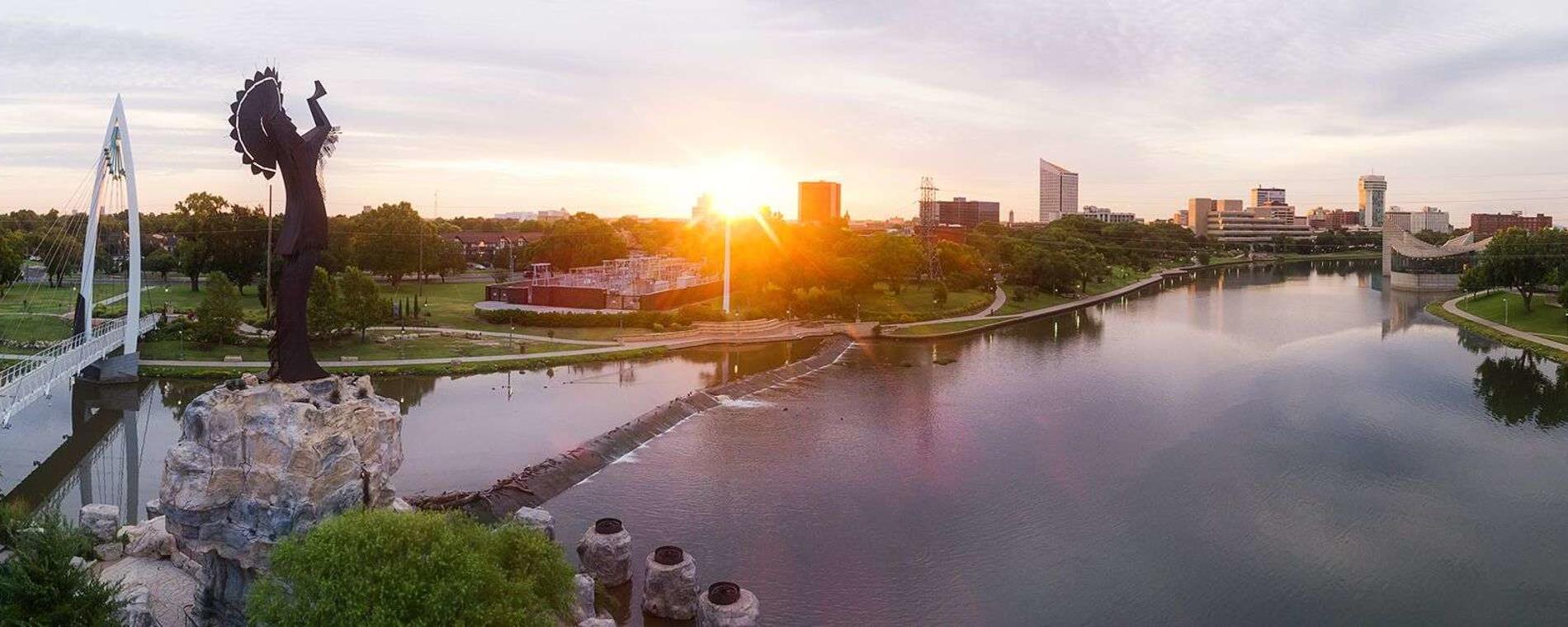Wichita History
Past, Present & Future
Wichita, the Heart of the Country, is the largest city in Kansas – full of significant aviation and western heritage. Our vibrant city radiates friendliness and ingenuity as the Air Capital of the World. From the passionate locals you meet at the 50-plus museums and attractions to the 1,200-plus eateries, kindness and energy greets you at every turn. The city is also noted for its breathtaking sunsets, beautiful weather, friendly residents, remarkable affordability and ease of getting around.
Once you discover Wichita's rich history and current vibe, you are sure to fall in love with Wichita!
Wichita's History
Wichita served as a trading center and meeting place for 11,000 years for nomadic people, but it wasn't until 1863 that the first permanent settlement of Wichita Indians was recorded. Shortly after, J.R. Mead became the first white settler when he opened a trading post and established the area as a base for the Chisholm Trail.
By 1870, Wichita was incorporated as a city, and a destination for cattle drives from Texas from whence it derived its nickname, "Cowtown." Rowdy roughnecks, loud dance hall saloons and cowboys driving cattle through town made the Historic Delano District a sight to see in the early 1870s. When the cattle trade moved west to take advantage of the construction of rail lines, Wichita fell on hard times. However, the city bounced back in the 1890s as grain began to more than equal the wealth formerly brought by cattle to become a trade and milling center.
The population of Wichita nearly doubled in 1918 after a great oil reserve was discovered nearby. In turn, the oil money allowed local entrepreneurs to invest in the up-and-coming airplane industry. Men like Lloyd Stearman, Walter Beech, and Clyde Cessna brought the industry to the area, and during World War II it was the major manufacturing center for airplanes needed in the war effort. Wichita remains the center for the aircraft industry, known as the "Air Capital of the World," producing 70% of U.S. general aviation aircraft.
The entrepreneurial spirit of those great pioneers continued to thrive in Wichita with other businesses like Coleman, White Castle, Pizza Hut, Big Dog Motorcycles, Freddy’s Frozen Custard & Steakburgers and Koch Industries.
Wichita Today
Today, Wichita has grown into an eclectic and lively city with some of the greatest arts and entertainment in the Midwest. It is a destination with something for everyone!
Want to experience Wichita’s western heritage? Make your first stop the Wichita-Sedgwick Co. Historical Museum. In the heart of downtown Wichita, this museum is located in the original 1890 Wichita City Hall with its 170-foot tall clock tower. It’s an exceptional, AAM-accredited museum featuring four floors of special and long-term exhibits examining Wichita and Sedgwick County’s rich history and cultural heritage. You’ll find one of the original Jones VI vehicles made in Wichita, the first electric guitar ever played and much more.
Step back in time and explore America's most authentic "Old West" town at Old Cowtown Museum, an outdoor, living history museum.
The city also attracts the talents of famous artists including Pavarotti and Broadway productions. Discover the talents of local and national artists at the Music Theatre of Wichita, Wichita Grand Opera, and the Wichita Symphony Orchestra. You can also take in the significant works of public art located throughout city along with an internationally-renowned collection of American art at the Wichita Art Museum.
Wichita is home to one of the country's top zoos, the Sedgwick County Zoo, with more than 3,000 animals of nearly 400 different species. The animals are not the only great attraction in Wichita, the museums are also world-class. You’ll also find the most interactive wildlife park in the Midwest, Tanganyika Wildlife Park, in the area. From feeding ring-tailed lemurs and pygmy hippos to Animal Meet & Greets, Behind the Scenes tours and more, you can get up-close-and-personal with many animals at Tanganyika. Plus, the park includes a splash pad to cool off on hot summer days.
Encounter hands-on exhibits at Exploration Place, the city's premier science center, or explore the history of the world at the Museum of World Treasures. Take a stroll through the fragrant gardens of Botanica Wichita. Delve into the Air Capital of the World’s rich aviation history at the Kansas Aviation Museum or uncover culture and heritage at the Kansas African American Museum and the Mid-American All-Indian Museum including the city's most iconic landmark, the Keeper of the Plains. In 1974, Native American artist Blackbear Bosin gifted the 44-foot-tall steel sculpture to the city. Designed to pay tribute to the area’s Indigenous people, construction began in 1970 and was completed in 1974. Decades later in 2007, a complete renovation was completed to elevate the sculpture and enhance the plaza surrounding the Keeper. The beautiful area now brings people out each evening to see the Keeper and the lit fire pots that surround it, known as the Ring of Fire.





